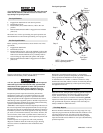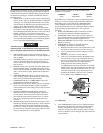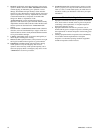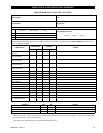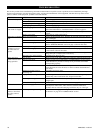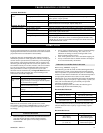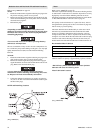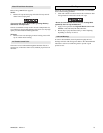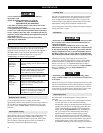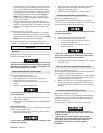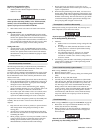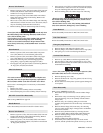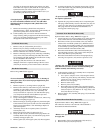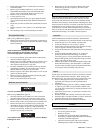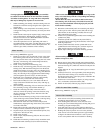
24 MHD56087 - Edition 4
REVIEW COPY 6
-
21
-
02
MAINTENANCE
WARNING
• Never perform maintenance on the winch while it is
supporting a load.
• Before performing maintenance, tag controls:
WARNING - DO NOT OPERATE -
EQUIPMENT BEING REPAIRED.
• Only allow personnel trained in safety and service on this
winch to perform maintenance.
• After performing any maintenance on the winch, test winch
to 125% of its rated line pull at mid drum before returning to
service. (Testing to more than 125% of rated line pull may be
required to comply with standards and regulations set forth in
areas outside the USA.)
• Shut off air system and depressurize air lines before
performing any maintenance.
Maintenance Intervals
The Maintenance Interval chart is based on intermittent operation
of winch eight hours each day, five days per week. If winch
operation exceeds eight hours per day, or use is under HEAVY or
SEVERE conditions, more frequent maintenance should be
performed. Refer to ‘Periodic Inspection’ on page 17 in
“INSPECTION” section for interval guidance.
Reduction Gear Assembly
It is recommend that the first oil change be done after
approximately 50 hours initial operation. Always inspect removed
oil for evidence of internal damage (metal shavings, dirt, water,
etc.). Refer to the “LUBRICATION” section for recommended
lubricants.
Thermoplastic Coating
Thermoplastic coating is an extremely tough and durable coating
designed to take the toughest treatment without chipping or
peeling. Special steps must be taken to protect the coating when
parts are removed, replaced and if excessive environmental or
operational conditions have damaged the coating.
Cleaning Parts
The area to be coated must be clean and free from loose coating.
Remove any surface corrosion. To paint thermoplastic coated
parts, the parts must be sand blasted in order to ‘rough up’ the
surface for proper paint adhesion. Sand blasting will not remove
thermoplastic coating (abrasive material will bounce off).
Loose coating can be removed by cutting with a sharp cutting tool
(chisel, putty knife or knife).
Heat Source
WARNING
• When using an open flame be aware of the materials around
the work area. Some solvents, lubricants and materials are
extremely flammable.
• Drain all components of lubricants, water or any other
fluids. Remove, or open all vents and drains. Components will
be hot and may discharge hot fluids or gases. Allow sufficient
time for components to cool, or cool off components, prior to
handling. Gaskets, seals, ‘O’ rings, and any components that
may be damaged should be removed prior to applying coating.
Thermoplastic coating is heat applied. The surface of the
component to which the thermoplastic coating is being applied
must be maintained at a temperature of at least 150° F (66° C),
but not over 170° F (77° C). Optimum temperature is 300° F
(149° C) for best results. A small propane torch (Ingersoll-Rand
Part No. 71308886) or heat gun (Ingersoll-Rand Part No.
71308894) can be used.
NOTICE
• When using a heat source always keep it moving. Small
circles work best. Failure to do so will result in a scorched area
at the repair.
The choice of heat gun or propane torch depends on the size of the
area to be coated and the amount of time available to accomplish
the task. The propane torch heats the surface faster, but is hard to
control and can scorch the coating. The heat gun is slower, easier
to control and generally results in a better looking finish.
Repairing Surfaces
For minor repairs to the thermoplastic coating conduct the
following:
1. If the under laying surface is not corroded and the scratch is
less than 1/16 inch (1.6 mm) wide the surrounding
thermoplastic coating can be heated until the material flows
together. For clean surfaces with damage greater than 1/16
inch (1.6 mm) heat the area and then apply thermoplastic
coating powder (Ingersoll-Rand Part No. 71308902 [2 oz.
(56.7 g)] to fill the area. Continue heating until coating
liquefies and flows together with the existing coating.
2. Corrosion in damaged area must be removed. Sandblast or
wire brush the area to remove corrosion. If corrosion exists,
ensure the corrosion has not penetrated below the surface of
existing thermoplastic coating. This can usually be easily
determined by checking to see if the coating is loose around
INTERVAL MAINTENANCE CHECK
Start of each shift
(Operator or
Maintenance
Personnel)
Make a thorough visual inspection of the
winch for damage. Do not operate winch if
damaged.
Operate winch at low RPM in both
directions. Winch must operate smoothly
without sticking, binding or abnormal
noises. Check operation of the brake(s).
3 Months
(Maintenance
Personnel)
Inspect drum brake friction linings. Clean
or replace parts as required. Adjust drum
brake as necessary.
Yearly
(Maintenance
Personnel)
Inspect the winch gearing, shafts and
bearings for wear and damage. Repair or
replace as necessary.
Check all supporting members, including
foundations, fasteners, nuts, sheaves and
rigging, etc. for indications of damage or
wear. Repair or replace as required.



